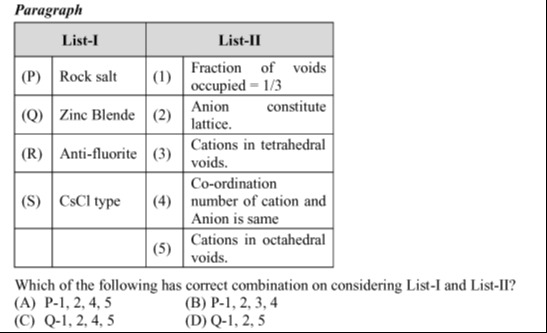Question
Question: | List-I | List-II | |:-------------------:|:-----...
| List-I | List-II |
|---|---|
| (P) Rock salt | (1) Fraction of voids occupied = 1/3 |
| (Q) Zinc Blende | (2) Anion constitute lattice. |
| (R) Anti-fluorite | (3) Cations in tetrahedral voids. |
| (S) CsCl type | (4) Co-ordination number of cation and Anion is same |
| (5) Cations in octahedral voids. |
Which of the following has correct combination on considering List-I and List-II?

A
P-1, 2, 4, 5
B
P-1, 2, 3, 4
C
Q-1, 2, 4, 5
D
Q-1, 2, 5
Answer
A
Explanation
Solution
Here is the analysis of each structure from List-I and its corresponding properties from List-II:
(P) Rock salt (e.g., NaCl)
- Structure: Anions (Cl⁻) form an FCC lattice. Cations (Na⁺) occupy all octahedral voids. There are 4 anions and 4 cations per unit cell.
- Lattice: Anion constitute lattice (2) - Yes.
- Cation location: Cations in octahedral voids (5) - Yes. Cations in tetrahedral voids (3) - No.
- Coordination number: Both cation and anion have coordination number 6. Co-ordination number of cation and Anion is same (4) - Yes.
- Voids occupied: In an FCC lattice with 4 anions, there are 4 octahedral voids and 8 tetrahedral voids (total 12 voids). All 4 octahedral voids are occupied by cations. Fraction of total voids occupied = 4/12 = 1/3. Fraction of voids occupied = 1/3 (1) - Yes.
- Matches for P: 1, 2, 4, 5.
(Q) Zinc Blende (e.g., ZnS)
- Structure: Anions (S²⁻) form an FCC lattice. Cations (Zn²⁺) occupy half of the tetrahedral voids (4 out of 8). There are 4 anions and 4 cations per unit cell.
- Lattice: Anion constitute lattice (2) - Yes.
- Cation location: Cations in tetrahedral voids (3) - Yes (half of them). Cations in octahedral voids (5) - No.
- Coordination number: Both cation and anion have coordination number 4. Co-ordination number of cation and Anion is same (4) - Yes.
- Voids occupied: In an FCC lattice with 4 anions, there are 4 octahedral voids and 8 tetrahedral voids (total 12 voids). 4 tetrahedral voids are occupied by cations. Fraction of total voids occupied = 4/12 = 1/3. Fraction of voids occupied = 1/3 (1) - Yes.
- Matches for Q: 1, 2, 3, 4.
(R) Anti-fluorite (e.g., Na₂O)
- Structure: Anions (O²⁻) form an FCC lattice. Cations (Na⁺) occupy all tetrahedral voids (8 out of 8). There are 4 anions and 8 cations per unit cell.
- Lattice: Anion constitute lattice (2) - Yes.
- Cation location: Cations in tetrahedral voids (3) - Yes (all of them). Cations in octahedral voids (5) - No.
- Coordination number: Cation (Na⁺) has CN 4, Anion (O²⁻) has CN 8. Co-ordination number of cation and Anion is same (4) - No.
- Voids occupied: In an FCC lattice with 4 anions, there are 4 octahedral voids and 8 tetrahedral voids (total 12 voids). All 8 tetrahedral voids are occupied by cations. Fraction of total voids occupied = 8/12 = 2/3. Fraction of voids occupied = 1/3 (1) - No.
- Matches for R: 2, 3.
(S) CsCl type
- Structure: Anions (Cl⁻) form a simple cubic lattice. Cations (Cs⁺) occupy the body center. There is 1 anion and 1 cation per unit cell.
- Lattice: Anion constitute lattice (2) - Yes (simple cubic).
- Cation location: Cations in tetrahedral voids (3) - No (in body center). Cations in octahedral voids (5) - No (in body center).
- Coordination number: Both cation and anion have coordination number 8. Co-ordination number of cation and Anion is same (4) - Yes.
- Voids occupied: Not typically described in terms of standard tetrahedral/octahedral voids of FCC/HCP. The body center is occupied. Fraction of voids occupied = 1/3 (1) - Unlikely.
- Matches for S: 2, 4.
Now let's check the given options: (A) P-1, 2, 4, 5: Matches for P are 1, 2, 4, 5. This combination is correct. (B) P-1, 2, 3, 4: P matches 1, 2, 4 but not 3. Incorrect. (C) Q-1, 2, 4, 5: Q matches 1, 2, 4 but not 5. Incorrect. (D) Q-1, 2, 5: Q matches 1, 2 but not 5. Incorrect.
The only correct combination provided in the options is (A).
